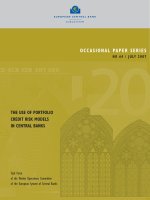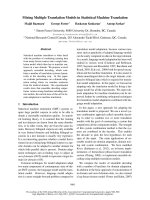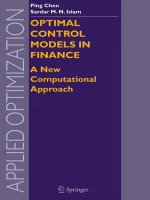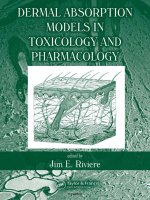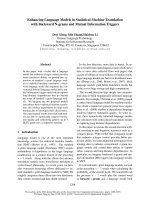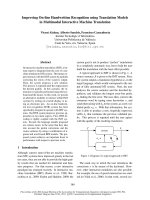Algebraic models in geometry
Bạn đang xem bản rút gọn của tài liệu. Xem và tải ngay bản đầy đủ của tài liệu tại đây (4.27 MB, 482 trang )
www.pdfgrip.com
Oxford Graduate Texts in Mathematics
Series Editors
R. Cohen S.K. Donaldson S. Hildebrandt
T.J. Lyons M.J. Taylor
www.pdfgrip.com
OXFORD GRADUATE TEXTS IN MATHEMATICS
Books in the series
1. Keith Hannabuss: An introduction to quantum theory
2. Reinhold Meise and Dietmar Vogt: Introduction to
functional analysis
3. James G. Oxley: Matroid theory
4. N.J. Hitchin, G.B. Segal, and R.S. Ward: Integrable systems:
twistors, loop groups, and Rieman surfaces
5. Wulf Rossmann: Lie groups: An introduction through linear groups
6. Qing Liu: Algebraic geometry and arithmetic curves
7. Martin R. Bridson and Simon M. Salamon (eds): Invitations to
geometry and topology
8. Shmuel Kantorovitz: Introduction to modern analysis
9. Terry Lawson: Topology: A geometric approach
10. Meinolf Geck: An introduction to algebraic geometry and algebraic
groups
11. Alastair Fletcher and Vladimir Markovic: Quasiconformal maps and
Teichmüller theory
12. Dominic Joyce: Riemannian holonomy groups and calibrated
geometry
13. Fernando Villegas: Experimental Number Theory
14. Péter Medvegyev: Stochastic Integration Theory
15. Martin Guest: From Quantum Cohomology to Integrable Systems
16. Alan Rendall: Partial Differential Equations in General Relativity
17. Yves Félix, John Oprea and Daniel Tanré: Algebraic Models
in Geometry
www.pdfgrip.com
Algebraic Models
in Geometry
Yves Félix
Département de Mathématiques
Université Catholique de Louvain-la-Neuve
Louvain-la-Neuve
Belgium
John Oprea
Department of Mathematics
Cleveland State University
Cleveland, USA
Daniel Tanré
Département de Mathématiques
Université des Sciences et Technologies de Lille
Lille, France
1
www.pdfgrip.com
3
Great Clarendon Street, Oxford OX2 6PD
Oxford University Press is a department of the University of Oxford.
It furthers the University’s objective of excellence in research, scholarship,
and education by publishing worldwide in
Oxford New York
Auckland Cape Town Dar es Salaam Hong Kong Karachi
Kuala Lumpur Madrid Melbourne Mexico City Nairobi
New Delhi Shanghai Taipei Toronto
With offices in
Argentina Austria Brazil Chile Czech Republic France Greece
Guatemala Hungary Italy Japan Poland Portugal Singapore
South Korea Switzerland Thailand Turkey Ukraine Vietnam
Oxford is a registered trade mark of Oxford University Press
in the UK and in certain other countries
Published in the United States
by Oxford University Press Inc., New York
© Y. Félix, J. Oprea, and D. Tanré 2008
The moral rights of the authors have been asserted
Database right Oxford University Press (maker)
First published 2008
All rights reserved. No part of this publication may be reproduced,
stored in a retrieval system, or transmitted, in any form or by any means,
without the prior permission in writing of Oxford University Press,
or as expressly permitted by law, or under terms agreed with the appropriate
reprographics rights organization. Enquiries concerning reproduction
outside the scope of the above should be sent to the Rights Department,
Oxford University Press, at the address above
You must not circulate this book in any other binding or cover
and you must impose the same condition on any acquirer
British Library Cataloguing in Publication Data
Data available
Library of Congress Cataloging in Publication Data
Data available
Typeset by Newgen Imaging Systems (P) Ltd., Chennai, India
Printed in Great Britain
on acid-free paper by
Biddles Ltd., King’s Lynn, Norfolk
ISBN 978–0–19–920651–3
ISBN 978–0–19–920652–0 (Pbk)
1 3 5 7 9 10 8 6 4 2
www.pdfgrip.com
To Agnès.
To mon Papillon: Kathy.
To the Magnificent Seven: Camille, Elsa, Amélie, Mathieu,
Thibault, Lucie, Maude.
www.pdfgrip.com
This page intentionally left blank
www.pdfgrip.com
Preface
Rational homotopy theory originated with the work of D. Quillen and
D. Sullivan in the late 1960s. In particular, Sullivan defined tools and models for rational homotopy inspired by already existing geometrical objects.
Moreover, he gave an explicit dictionary between his minimal models and
spaces, and this facility of transition between algebra and topology has created many new topological and geometrical theorems in the last 30 years.
An introduction to rational homotopy whose main applications were in
algebraic topology was written some years ago. Because of recent developments, it is clear that now is the time for a global presentation of some of
the more representative geometrical applications of minimal models. That
is the theme of this book.
Before giving an overview of its content, we present the basic philosophy
behind the theory of minimal models. As Sullivan wrote in the introduction
of Infinitesimal Computations in Topology:
We have suggested here that one might therefore recall the older methods of
differential forms, which are evidently quite powerful.
When de Rham proved that H ∗ (ADR (M)) ∼
= H ∗ (M; R) for the differential algebra of differential forms ADR (M) on a manifold M, it immediately
provided a link between the analysis on and the topology of the manifold.
Sullivan is suggesting in his remark that even within the world of topology,
there is more topological information in ADR (M) (henceforth called the de
Rham algebra of M) than simply the real cohomology.
For a compact connected Lie group G, there exists a subdifferential algebra of bi-invariant forms, I (G), inside the de Rham algebra ADR (G), such
that the canonical inclusion I (G) → ADR (G) induces an isomorphism
in cohomology. This is the prototype of the process for models: namely,
we look for a simplification MM of the de Rham algebra with an explicit
differential morphism MM → ADR (M) inducing an isomorphism in cohomology, exactly as bi-invariant forms do in the case of a compact connected
Lie group.
In order to implement this strategy, we first have to make precise what a
“simplification” means. In the de Rham algebra, we might suspect that
some information is contained in two different entities: the product of
www.pdfgrip.com
viii
Preface
forms, which tells us how two forms can be combined together to give
a third one and the exterior derivative of a form. In a model, we kill the
information coming from the product structure by considering free algebras ∧V (in the commutative graded sense) where V is an R-vector space.
This pushes the corresponding information into the differential and into V
where it is easier to detect. More precisely, we look for a cdga (for commutative differential graded algebra) free as a commutative graded algebra
(∧V, d) and a morphism ϕ : (∧V, d) → ADR (M) inducing an isomorphism
in cohomology.
The first question is, can one build such a model for any manifold? The
answer is yes for connected manifolds and in fact, there are many ways to
do this. So, we have to define a standard way, which we call minimal. With
this in mind, we again look to Sullivan’s introduction:
One proceeds degree by degree to construct a smallest possible sub-differential
algebra of forms with the same cohomology. Forms are chosen in each degree
to add cohomology not already achieved or to create necessary relations among
cohomology classes.
Once we have this minimal model, we may ask what geometrical invariants can be detected in it. In fact, there is a functor from algebra to geometry
that, together with forms, creates a dictionary between the algebraic and
the geometrical worlds. But for this we have to work over the rationals
and not over the reals. As a consequence, we have to replace the de Rham
algebra by other types of forms. At first glance, this seems to be a disadvantage because we are switching from a well-known object to an unfamiliar
one. But this new construction is very similar to the de Rham algebra and
will allow the extension of the usual theory from manifolds to topological
spaces, which is a great advantage. Denote by APL (X) this analogue of the
de Rham algebra for a topological space X. Since the minimal model construction also works perfectly well over Q, we have the notion of a minimal
model MX → APL (X) of a path connected space X.
Conversely, from a cdga (A, d) we have a topological realization (A, d)
which is the return to Topology we hinted at above. If we apply this realization to a minimal model MX of a space X (which is nilpotent with finite
Betti numbers), then we get a continuous map X → MX which induces an
isomorphism in rational cohomology. The space MX is what, in homotopy theory, is called a rationalization of X. What must be emphasized in
this process is the ability to create topological realizations of any algebraic
constructions.
Such a theory begs for applications and examples and we describe
models for spheres, homogeneous spaces, biquotients, connected sums,
www.pdfgrip.com
Preface
nilmanifolds, mapping spaces, configuration spaces and subspace arrangements. We give geometrical applications in several directions: to complex
and symplectic manifolds, the closed geodesic problem, curvature problems,
actions of tori, complements of submanifolds, symplectic blow-ups, and the
Chas–Sullivan product, for instance.
Roughly, this book is composed of three parts. The first part, consisting
of Chapters 1–3, contains the classical theory and the main geometrical
examples. These chapters are self-contained except for certain proofs for
which we provide references.
Chapters 4–8 are the second part. Each of them is devoted to a particular
topic in differential topology or geometry and they are mostly independent.
The third part is the florilège of Chapter 9 where we give short presentations of particular subjects, chosen to illustrate the evolution of applications
of minimal models from the theory’s inception to the present day. Evidently
we have been obliged to make choices in these applications and, therefore,
many other interesting applications of algebraic models are not covered.
The following brief description of the material in each of the chapters
makes the outline above more precise.
• Chapter 1. Throughout this book, Lie groups and homogeneous spaces
are used to give foundational examples and to show that some of the
basic ideas of Sullivan’s rational homotopy theory were already present
in this particular case years earlier. As well as describing certain basic
structure results about Lie groups, this chapter gives a complete treatment
of the computation of the cohomology algebra of a compact connected
Lie group and recalls the basic facts about homogeneous spaces. We also
look at the Cartan–Weil model and see it as the prototype for models of
fibrations.
• Chapter 2 is concerned with the basic definitions and properties of our
algebraic tools: cdga’s, models, minimal models, homotopy between morphisms of cdga’s and the link between topological spaces and cdga’s.
When we construct a minimal model for a cdga (A, d), it is possible that
we do not have to consider the whole algebra of forms, but rather only
the cohomology H(A, d). Although this is not true in general, it is true
for spheres and Lie groups. This leads us to distinguish special types of
spaces, called formal spaces, whose minimal models are determined by
cohomology alone. This notion will be of great importance in applications
and we delineate its properties.
• Chapter 3. Since the main theme of this book is the geometrical aspect of
algebraic models, a first question is, how special is a minimal model of
a compact simply connected manifold? At the very least, its cohomology
must satisfy Poincaré duality. In fact, it was proved recently that there is a
ix
www.pdfgrip.com
x
Preface
model for X (and not just its cohomology) that satisfies Poincaré duality.
What about the converse? How can we detect that the realization of a
model contains a manifold in its rational homotopy type? Surprisingly,
the conditions that are necessary for this also prove to be sufficient.
Formality in the case of manifolds entails certain properties. We prove
here the theorems of Miller and Stasheff giving particular instances when
manifolds are formal. Notably, we show, as Stasheff did using another
method, that a compact simply connected manifold M is formal if and
only if M\{∗} is formal.
We also extend the construction of models to the case of cdga’s
equipped with the action of a finite group and apply it to the explicit
construction of models of homogeneous spaces and biquotients.
• In Chapter 4, we study the link between the Dolbeault and de Rham
algebras of a complex manifold M as well as the relationship between the
respective models. We carefully consider the topological consequences of
the existence of a Kähler metric on M, and, in particular, we prove the
formality of compact Kähler manifolds. We also consider the Dolbeault
model of a complex manifold in detail and compute it in many particular
cases, including the case of Calabi-Eckmann manifolds. For that, we use
a perturbation theorem which allows the construction of a model of a
filtered cdga starting from a model of any stage of the associated spectral
sequence. Applications to the Frölicher spectral sequence of a complex
manifold are given.
In the last part of this chapter, we describe some of the implications of
models for symplectic topology. For a compact symplectic manifold, we
compare the hard Lefschetz property with other properties that appear
in the complex situation. In particular, we recall results of Mathieu and
Merkulov concerning the relation of the hard Lefschetz property to the
existence of symplectically harmonic forms, as defined by Brylinski, in
each cohomology class.
• Chapter 5. For a smooth Riemannian manifold, the Riemannian structure
of the manifold is reflected in its geodesics. The geodesics on a manifold
may be viewed as the motion of a physical system, so in some sense, the
study of geodesics exemplifies the paradigm expressing the relationship
between mathematics and physics. Of course, the motions that are most
important in physics are the periodic ones, so we begin by studying the
geometric counterpart, closed geodesics.
The main problem in this area is then: does every compact Riemannian
manifold M of dimension at least two admit infinitely many geometrically
distinct geodesics? The solution to this problem involves an essential analysis of the rational homotopy type of the free loop space of the manifold.
www.pdfgrip.com
Preface
We give a minimal model of the free loop space and then prove the Vigué–
Poirrier–Sullivan theorem, which solves most cases of the closed geodesic
problem.
We also present several other connections between the structure of models and properties of a manifold’s geodesics. Information about geodesics
can often be codified by the dynamical system known as the geodesic flow
and we shall see that the flow also holds rational homotopy information
within it.
• Chapter 6. In the last decade, algebraic models have proven to be useful
tools in the study of various differential geometric questions involving
curvature. A basic problem is whether curvature and diameter constraints
limit to a finite number the possible rational homotopy types of manifolds
satisfying those constraints. We describe the use of models in the construction of counterexamples to this question. We also show how models
can be used to give a general analysis of the failure of the converse of the
Soul theorem of Cheeger and Gromoll.
• Chapter 7. The topological qualities of a space are often reflected in its
intrinsic symmetries. These symmetries, in turn, may be formalized as the
actions of groups on the space. Intuitively, most manifolds are asymmetric, so the existence of a nontrivial group action on a manifold implies
that the manifold is special topologically. The properties of a manifold
with group action may be gleaned from various topological constructions
and their algebraic reflections. Indeed, this chapter focuses on what can
be said about group actions from the viewpoint of algebraic models. For
instance, there is a longstanding conjecture called the toral rank conjecture which is usually attributed to S. Halperin. The conjecture says, in
particular, that if there is a free action of a torus T r on a space X, then
the dimension of the rational cohomology of X must be at least as large
as the dimension of the rational cohomology of the torus. We give proofs
for homogeneous spaces and Kähler manifolds.
We also discuss the Borel localization theorem and apply it to the study
of the rational homotopy and the rational cohomology of fixed point
sets. Finally, we discuss the notion of Hamiltonian action in symplectic
geometry and use models to prove a special case of the Lalonde–McDuff
question about Hamiltonian bundles.
• Chapter 8. The process of taking a blow-up has proven to be extremely
useful in complex and symplectic geometry. In order to consider various
questions on the interface between geometry and algebraic topology, it
is necessary to understand algebraic models of blow-ups. This entails a
panoply of related questions which all serve as testaments to the efficacy
of rational homotopy theory in geometry. In this chapter we consider two
types of questions.
xi
www.pdfgrip.com
xii
Preface
First of all, let f : N → M be a closed submanifold of a compact orientable manifold and denote by C its complement. The natural problem
is to know if the rational homotopy type of C is completely determined by
the rational homotopy type of the embedding, and in that case to describe
a model for the injection C → M from a model of the initial embedding.
We use it to describe nonformal simply connected symplectic manifolds
that are blow-ups.
Our second question concerns the geometric intersection theory of
cycles in a compact manifold. M. Chas and D. Sullivan have extended
the standard intersection theory to an intersection theory of cycles in the
free loop space LN for any compact oriented manifold N. More precisely,
they define a product on H∗ (LN) that combines the intersection product
on the chains on N and the Pontryagin composition of loops in N. We
present a more homological re-interpretation of the Chas–Sullivan product and, as a corollary, obtain the well-known theorem of Cohen and
Jones.
• In Chapter 9, we consider various types of geometric situations where
algebraic models are useful. Models make their presence felt in the
study of configuration spaces, arrangements, smooth algebraic varieties,
mapping spaces, Gelfand–Fuchs cohomology, and iterated integrals. Of
course, it is impossible to prove everything about such an array of topics,
so this chapter is simply a survey of these applications of models. We
endeavor to describe and explain the relevant models and then refer to
the appropriate literature for details.
• Finally, there are three appendices that recall basic facts about de Rham
forms, spectral sequences and homotopy theory.
It is our hope (and we believe) that this book will prove enlightening to
both geometers and topologists. It should be useful to geometers because of
concrete examples showing how algebraic techniques can be used to help
solve geometric problems. For topologists, on the other hand, it is important
to see what kind of concrete geometrical questions can be studied from a
topological point of view.
A project such as this requires a great deal of support and we would
like to acknowledge this here. First, this book would never have seen the
light of day without Research in Pairs grants from the Mathematisches
Forschungsinstitut Oberwolfach in 2003 and 2006. These stays at the MFO
were essential to our collaboration and it is a pleasure to acknowledge
the generosity of this mathematical haven. Various portions of the book
were read by Agusti Roig and he provided many insightful comments and
suggestions. We also thank P. Lambrechts and G. Paternain for discussions
www.pdfgrip.com
Preface
on several topics. Finally, the support of the University of Louvain-LaNeuve and of the CNRS for the Summer School on Algebraic Models, held
at Louvain-La-Neuve in June 2007, was essential to the completion of this
work.
Let’s now begin.
xiii
www.pdfgrip.com
This page intentionally left blank
www.pdfgrip.com
Contents
vii
Preface
1
Lie groups and homogeneous spaces
1.1
1.2
1.3
1.4
1.5
1.6
1.7
1.8
1.9
1.10
1.11
1.12
1.13
2
Lie groups
Lie algebras
Lie groups and Lie algebras
Abelian Lie groups
Classical examples of Lie groups
1.5.1 Subgroups of the real linear group
1.5.2 Subgroups of the complex linear group
1.5.3 Subgroups of the quaternionic linear group
Invariant forms
Cohomology of Lie groups
Simple and semisimple compact connected
Lie groups
Homogeneous spaces
Principal bundles
Classifying spaces of Lie groups
Stiefel and Grassmann manifolds
The Cartan–Weil model
1
2
3
5
8
8
9
10
10
11
16
21
26
32
38
42
47
Minimal models
56
2.1
2.2
2.3
57
61
64
64
66
67
67
69
2.4
Commutative differential graded algebras
Homotopy between morphisms of cdga’s
Models in algebra
2.3.1 Minimal models of cdga’s and morphisms
2.3.2 Relative minimal models
Models of spaces
2.4.1 Real and rational minimal models
2.4.2 Construction of APL (X)
www.pdfgrip.com
xvi
Contents
2.5
2.6
2.7
2.8
3
71
74
75
75
78
84
87
90
90
91
92
95
96
100
Manifolds
104
3.1
105
105
106
109
110
116
117
121
123
123
127
133
133
137
139
3.2
3.3
3.4
3.5
4
2.4.3 Examples of minimal models of spaces
2.4.4 Other models for spaces
Minimal models and homotopy theory
2.5.1 Minimal models and homotopy groups
2.5.2 Relative minimal model of a fibration
2.5.3 The dichotomy theorem
2.5.4 Minimal models and some homotopy constructions
Realizing minimal cdga’s as spaces
2.6.1 Topological realization of a minimal cdga
2.6.2 The cochains on a graded Lie algebra
Formality
2.7.1 Bigraded model
2.7.2 Obstructions to formality
Semifree models
Minimal models and manifolds
3.1.1 Sullivan–Barge classification
3.1.2 The rational homotopy groups of a manifold
3.1.3 Poincaré duality models
3.1.4 Formality of manifolds
Nilmanifolds
3.2.1 Relations with Lie algebras
3.2.2 Relations with principal bundles
Finite group actions
3.3.1 An equivariant model for -spaces
3.3.2 Weyl group and cohomology of BG
Biquotients
3.4.1 Definitions and properties
3.4.2 Models of biquotients
The canonical model of a Riemannian manifold
Complex and symplectic manifolds
145
4.1
148
148
150
Complex and almost complex manifolds
4.1.1 Complex manifolds
4.1.2 Almost complex manifolds
4.1.3 Differential forms on an almost
complex manifold
4.1.4 Integrability of almost complex manifolds
152
154
www.pdfgrip.com
Contents
4.2
4.3
4.4
4.5
4.6
4.7
5
Kähler manifolds
4.2.1 Definitions and properties
4.2.2 Examples: Calabi–Eckmann manifolds
4.2.3 Topology of compact Kähler manifolds
The Dolbeault model of a complex manifold
4.3.1 Definition and existence
4.3.2 The Dolbeault model of a Kähler manifold
4.3.3 The Borel spectral sequence
4.3.4 The Dolbeault model of Calabi–Eckmann
manifolds
The Frölicher spectral sequence
4.4.1 Definition and properties
4.4.2 Pittie’s examples
Symplectic manifolds
4.5.1 Definition of symplectic manifold
4.5.2 Examples of symplectic manifolds
4.5.3 Symplectic manifolds and the hard
Lefschetz property
4.5.4 Symplectic and complex manifolds
Cohomologically symplectic manifolds
4.6.1 C-symplectic manifolds
4.6.2 Symplectic homogeneous spaces and
biquotients
4.6.3 Symplectic fibrations
4.6.4 Symplectic nilmanifolds
4.6.5 Homotopy of nilpotent symplectic manifolds
Appendix: Complex and symplectic linear algebra
4.7.1 Complex structure on a real vector space
4.7.2 Complexification of a complex structure
4.7.3 Hermitian products
4.7.4 Symplectic linear algebra
4.7.5 Symplectic and complex linear algebra
4.7.6 Generalized complex structure
156
156
159
162
168
169
172
173
175
178
178
179
182
182
183
184
187
187
187
188
189
191
194
196
196
197
198
200
201
202
Geodesics
205
5.1
5.2
5.3
5.4
5.5
207
210
213
215
222
The closed geodesic problem
A model for the free loop space
A solution to the closed geodesic problem
A-invariant closed geodesics
Existence of infinitely many A-invariant geodesics
xvii
www.pdfgrip.com
xviii
Contents
5.6
5.7
5.8
5.9
6
223
227
232
234
Curvature
239
6.1
6.2
239
243
243
249
252
253
259
265
266
6.3
6.4
6.5
7
Gromov’s estimate and the growth of
closed geodesics
The topological entropy
Manifolds whose geodesics are closed
Bar construction, Hochschild homology and cohomology
Introduction: Recollections on curvature
Grove’s question
6.2.1 The Fang–Rong approach
6.2.2 Totaro’s approach
Vampiric vector bundles
6.3.1 The examples of Özaydin and Walschap
6.3.2 The method of Belegradek and Kapovitch
Final thoughts
Appendix
G-spaces
271
7.1
7.2
7.3
273
275
276
278
280
283
287
289
291
292
295
298
298
303
305
306
306
308
312
312
314
7.4
7.5
7.6
Basic definitions and results
The Borel fibration
The toral rank
7.3.1 Toral rank for rationally elliptic spaces
7.3.2 Computation of rk0 (M) with minimal models
7.3.3 The toral rank conjecture
7.3.4 Toral rank and center of π∗ ( M) ⊗ Q
7.3.5 The TRC for Lie algebras
The localization theorem
7.4.1 Relations between G-manifold and fixed set
7.4.2 Some examples
The rational homotopy of a fixed point set component
7.5.1 The rational homotopy groups of a component
7.5.2 Presentation of the Lie algebra LF = π∗ ( F) ⊗ Q
7.5.3 Z/2Z-Sullivan models
Hamiltonian actions and bundles
7.6.1 Basic definitions and properties
7.6.2 Hamiltonian and cohomologically free actions
7.6.3 The symplectic toral rank theorem
7.6.4 Some properties of Hamiltonian actions
7.6.5 Hamiltonian bundles
www.pdfgrip.com
Contents
8
Blow-ups and Intersection Products
317
8.1
318
319
321
324
328
8.2
8.3
8.4
9
The model of the complement of a submanifold
8.1.1 Shriek maps
8.1.2 Algebraic mapping cones
8.1.3 The model for the complement C
8.1.4 Properties of Poincaré duality models
8.1.5 The configuration space of two points in
a manifold
Symplectic blow-ups
8.2.1 Complex blow-ups
8.2.2 Blowing up along a submanifold
A model for a symplectic blow-up
8.3.1 The basic pullback diagram of PL-forms
8.3.2 An illustrative example
8.3.3 The model for the blow-up
8.3.4 McDuff’s example
8.3.5 Effect of the symplectic form on the blow-up
8.3.6 Vanishing of Chern classes for KT
The Chas-Sullivan loop product on loop space
homology
8.4.1 The classical intersection product
8.4.2 The Chas–Sullivan loop product
8.4.3 A rational model for the loop product
8.4.4 Hochschild cohomology and Cohen–Jones
theorem
8.4.5 The Chas-Sullivan loop product and
closed geodesics
329
330
331
332
334
334
334
335
337
339
339
341
341
342
344
346
348
A Florilège of geometric applications
350
9.1
351
352
353
354
355
358
9.2
Configuration spaces
9.1.1 The Fadell–Neuwirth fibrations
9.1.2 The rational homotopy of configuration spaces
9.1.3 The configuration spaces F(Rn , k)
9.1.4 The configuration spaces of a projective manifold
Arrangements
9.2.1 Formality of the complement of a geometric
lattice
9.2.2 Rational hyperbolicity of the space M(A)
361
362
xix
www.pdfgrip.com
xx
Contents
9.3
9.4
9.5
9.6
9.7
A
B
Toric topology
Complex smooth algebraic varieties
Spaces of sections and Gelfand–Fuchs cohomology
9.5.1 The Haefliger model for spaces of sections
9.5.2 The Bousfield–Peterson–Smith model
9.5.3 Configuration spaces and spaces of sections
9.5.4 Gelfand–Fuchs cohomology
Iterated integrals
9.6.1 Definition of iterated integrals
9.6.2 The cdga of iterated integrals
9.6.3 Iterated integrals and the double bar
construction
9.6.4 Iterated integrals, the Hochschild complex and
the free loop space
9.6.5 Formal homology connection and holonomy
9.6.6 A topological application
Cohomological conjectures
9.7.1 The toral rank conjecture
9.7.2 The Halperin conjecture
9.7.3 The Bott conjecture
9.7.4 The Gromov conjecture on LM
9.7.5 The Lalonde–McDuff question
363
364
367
367
371
373
375
376
376
379
381
384
385
387
388
388
388
389
390
390
De Rham forms
392
A.1
A.2
A.3
A.4
392
398
402
404
Differential forms
Operators on forms
The de Rham theorem
The Hodge decomposition
Spectral sequences
409
B.1
B.2
B.3
B.4
B.5
B.6
409
411
412
413
416
B.7
What is a spectral sequence?
Spectral sequences in cohomology
Spectral sequences and filtrations
Serre spectral sequence
Zeeman–Moore theorem
An algebraic example: The odd spectral
sequence
A particular case: A double complex
419
420
www.pdfgrip.com
Contents
C
Basic homotopy recollections
C.1
C.2
C.3
n-equivalences and homotopy sets
Homotopy pushouts and pullbacks
Cofibrations and fibrations
423
423
424
428
References
433
Index
451
xxi
www.pdfgrip.com
This page intentionally left blank
www.pdfgrip.com
1
Lie groups and
homogeneous spaces
Lie groups and homogeneous spaces form an important family of examples
of manifolds. We will use them systematically in many different parts of
this book, to give an illustration for a specific method or, as well, to show
that new viewpoints can be obtained by using algebraic models. Therefore,
it is important for us to understand basic ideas and results about Lie groups
in order to appreciate the development and application of algebraic models
to geometry in general.
What we also want to articulate in the next several chapters is that some of
the basic ideas of Sullivan’s rational homotopy theory were already present
in this particular case. Of course, the (rational or real) cohomology algebra
is a fundamental example of an algebraic model, but it was understood from
the start that only certain information was reflected in it. Nevertheless, computing cohomology for such geometric building blocks as Lie groups became
an important goal in the early years of algebraic topology. An algebraic
model that proved to be effective in reaching this goal was the Cartan–Weil
model. Nowadays, we look at this model and see it as the direct ancestor
of Sullivan’s minimal models. Indeed, the Cartan–Weil model is the prototype for models of fibrations (see Chapter 2) and, thus holds within it
homotopical, rather than just cohomological, information.
A complete treatment of Lie group theory covers several books, so we
need to make precise the philosophy of this chapter. Basic properties and
definitions on Lie groups and Lie algebras are recalled without proofs in
Sections 1.1–1.4. The classical examples of groups of matrices are described
in Section 1.5. From that point on, we wish to be complete, with proofs,
when we discuss the things that form the main focus of the book: here, that
means in particular, the de Rham cohomology of Lie groups and homogeneous spaces. Moreover, and we will discover the importance of this in
Chapter 2, we wish to have a “computable” cochain complex
linked
to the de Rham complex by an algebraic map, → ADR , which induces
an isomorphism in cohomology. For instance, in the case of Lie groups, we
prove in Section 1.6 that the inclusion I (G) → ADR (G) of the bi-invariant
www.pdfgrip.com
2
1 : Lie groups and homogeneous spaces
forms induces an isomorphism in cohomology. We continue in Section 1.7
by providing two structure theorems for the cohomology of Lie groups,
including the Hopf theorem which expresses the cohomology algebra as an
exterior algebra on generators of odd degrees. We will use this result in
Section 1.8 for the computation of the second and third Betti numbers for
simple Lie groups.
Since fibrations are the basic ingredients in the theory of minimal models, we develop the notions of principal bundles and classifying spaces.
Sections 1.9–1.10 contain definitions of bundles, principal bundles and
homogeneous spaces. In Section 1.11, we define and characterize the notion
of classifying space for Lie groups. The classical Stiefel and Grassmann manifolds provide us with classifying spaces for the various orthogonal groups
and they are studied in Section 1.12. Finally, in Section 1.13, we give the prototype for the theory of minimal models (see Chapter 2), the Cartan–Weil
model for equivariant cohomology.
We assume that the reader possesses a good knowledge of the basic concepts about manifolds, as in [28], [104], [226], or (for surface theory) [215]
for instance. We also assume the reader has had a classical homology course.
Appendices A, B and C supply the basic recollections on some crucial parts
of these subjects.
In this chapter, manifold means a Hausdorff space with a countable basis
of open sets (i.e. a separable space), endowed with a differentiable structure
of class C ∞ over the reals.
1.1
Lie groups
In this section, we give the definitions and basic properties of Lie groups.
General references are [2], [136] and [199] for instance.
Definition 1.1 A Lie group is a set G which is both a manifold and a
group and for which the multiplication, (g, g ) → gg , and the inverse map,
g → g −1 , are smooth. The dimension of a Lie group is its dimension as a
manifold.
A homomorphism of Lie groups is a homomorphism of groups which
is also a smooth map. An isomorphism of Lie groups is a homomorphism f which admits an inverse f −1 as maps and such that f −1 is also
a homomorphism of Lie groups.
For instance, R and S1 are Lie groups for the usual structures of manifolds
and groups. One can observe directly from the definition that a product of
two Lie groups is a Lie group for the two canonical structures, product of
groups and product of manifolds. So Rn and (S1 )n are Lie groups. The tori
